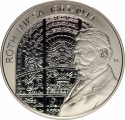You are about to finish your registration. Please check your mailbox (including spam folder). There should be a letter with a confirmation link. Check setting to make sure that your e-mail address is correct.
Send letter againDescription
Miksa Róth (1865–1944) was a renowned Hungarian stained glass artist and mosaicist. In 1885, he founded his own stained glass art institute, advancing his craft to artistic prominence. His style evolved from historicism to incorporate elements of secession and art deco, often blending these styles seamlessly.
Róth's exquisite works grace many prominent buildings, including the Hungarian Parliament, Gresham Palace (now a hotel), the former Austro-Hungarian Bank (now the Hungarian National Bank), and the Liszt Academy of Music. His notable mosaic creations include those at Szervita Square, the Széchenyi Bath, and the Deák and Kossuth Mausoleums.
His international contributions include stained glass windows for the Royal Palace in The Hague, Fagerborg Church in Oslo, and the National Theatre in Mexico City. He also showcased his art at various exhibitions, including the Hungarian Pavilion at the Venice Biennale.
Róth received numerous accolades, both domestically and internationally. In 1898, he was the first to be awarded the State Gold Medal for Applied Arts. He won a silver medal at the 1900 Paris World's Fair and gold medals at the 1902 Turin and 1904 St. Louis World's Fairs. Domestically, he was honored with the Knight's Cross of the Order of Franz Joseph and later appointed as Chief Government Councillor.
Engraver: Zoltán Tóth
Obverse

|
Depicts the portrait of Róth Miksa, with a glass window he created in the background, located in the building of the Magyar Nemzeti Bank. Along the edge, on the left side, the inscription "RÓTH MIKSA" and the birth and death years "1865-1944" are visible in a semi-circular manner. On the right side, in the center, the engraver's privy mark is placed. RÓTH MIKSA 1865-1944 |
|---|---|
Reverse

|
Depicts a detail of the Hungarian National Bank building. On the left, in horizontal rows, the denomination and the inscription "FORINT" are positioned centrally, while at the bottom, the issuance year "2015" and the mint mark "BP" are visible. Along the edge, on the left side, the inscription "HUNGARY" is displayed in a semi-circular manner. MAGYARORSZÁG |
| Edge |
2000 Forint
KM# 883 Adamo# EM306
Characteristics
| Type | Commemorative Issue (Non-circulating) |
| Material | Copper Nickel |
| Weight | 23.7 g |
| Diameter | 37 mm |
| Thickness | - |
| Shape |
|
| Alignment | Medal |
| Mint |
Budapest Mint (BP)
|



